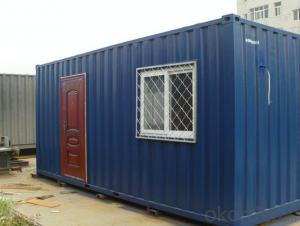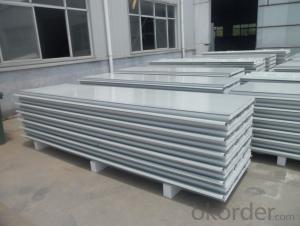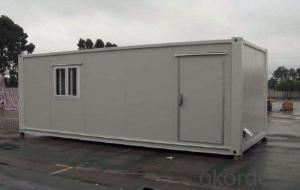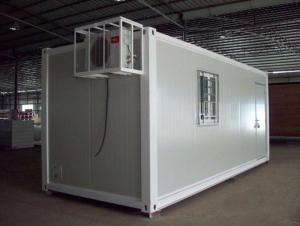container homes for sale
- Loading Port:
- Tianjin
- Payment Terms:
- TT OR LC
- Min Order Qty:
- -
- Supply Capability:
- 20000 Set set/month
OKorder Service Pledge
OKorder Financial Service
You Might Also Like
container homes for sale
The folding container is good for sea container transport with various use.
The container is made of chassis, wall, roof and decorative profiles. They can
joint together with individual containers in longitudinal and transverse directions.
And it can be assembled as max 3 floors.
Its materials are environmental friendly. One standard set container house
weight is about 1.8Ton.We can pack 3 sets houses as one flat package for bulk
transportation, or load 6 sets houses in one 40ft sea container.
House Size:
1) External length /inner length: 5950mm/5700mm
2) External width/inner width: 2310mm/2060mm
3) External height/inner width: 2740mm/2400mm
4) Floors: max 3 floors
House Body:
1) Door: outside door as SIP door, aluminium alloy door or security door.
inside door as SIP door, aluminium alloy door or Compound wooden door
2) Window: PVC material or aluminium alloy with window screen
3) Wall system: sandwich panel's insulation material of sandwich panels are
EPS/XPS/PU/ROCK WOOL, GLASS WOOL, etc. The thickness: from 50mm to
100mm
4) Roof system: knock down in factory
5) Compression decorative parts: made of 0.4mm thick color steel sheet
6) Ceiling board: EPS color steel sandwich panel, rock wool, PU for the
insulation or MDF plate mobile container house
Design technical data:
1) Wind load: 0.65KN/sqm
2) Roof live load: 0.5KN/sqm
3) Earthquake intensity: 8 grade
4) Location temperature:-25ºC to 45ºC
Installation efficiency:
Four skilled labors can assemble 1 set house body in 2 hours.
Container transportation:
Every 40HQ may load 6 sets houses body stuff.
- Q:Can container houses be used for temporary housing solutions?
- Yes, container houses can be used for temporary housing solutions. They are portable, cost-effective, and can be easily transported and installed in various locations. Container houses provide a quick and convenient solution for temporary housing needs such as disaster relief efforts, construction projects, or temporary accommodation during events or festivals.
- Q:Can container houses be built on uneven terrain?
- Yes, container houses can be built on uneven terrain. One of the advantages of using shipping containers for building homes is their versatility and adaptability to different landscapes. With proper preparation and foundation work, containers can be placed and secured on uneven terrain. The process usually involves leveling the ground, creating a stable foundation, and using support beams or piers to ensure stability. Additionally, modifications can be made to the containers themselves, such as cutting and welding, to conform to the uneven terrain and create a level living space inside. Overall, while some additional planning and construction may be required, container houses can definitely be built on uneven terrain.
- Q:Can container houses be designed for multi-story living?
- Yes, container houses can be designed for multi-story living. With proper engineering and design, containers can be stacked and interconnected to create multi-story structures.
- Q:Can container houses be designed with a modern or contemporary aesthetic?
- Certainly, container houses can be designed with a modern or contemporary aesthetic without a doubt. In fact, numerous architects and designers have eagerly embraced the utilization of shipping containers as a sustainable and cost-effective building material, while also incorporating sleek and trendy designs. One of the advantages of utilizing container houses for modern or contemporary designs lies in their clean and industrial appearance. The containers' metal structure, characterized by straight lines and geometric shapes, lends itself well to a modern aesthetic. Moreover, the containers' uniformity allows for modular design, which can be easily customized to create a contemporary look. Designers often integrate large windows, open floor plans, and minimalist interiors to enhance the modern atmosphere of container houses. This not only allows for ample natural light and an airy ambiance but also ensures a seamless integration between indoor and outdoor spaces. Furthermore, the use of high-quality finishes, such as wood or polished concrete, can further enhance the overall contemporary aesthetic of the container house. Furthermore, container houses can be creatively stacked or arranged to create unique and visually captivating designs. Architects have experimented with cantilevered sections, rooftop gardens, and even multi-story container structures, all of which contribute to a modern and cutting-edge appearance. Ultimately, container houses present a versatile canvas for modern or contemporary designs. With the right architectural vision and meticulous attention to detail, these structures can be transformed into stylish and visually appealing homes that flawlessly blend sustainability and aesthetics.
- Q:Can container houses be designed for high-end luxury?
- Yes, container houses can certainly be designed for high-end luxury. While the concept of using shipping containers for housing may initially evoke images of minimalistic and utilitarian designs, it is important to note that container houses can be customized and transformed to meet the highest standards of luxury living. Container houses offer a unique opportunity for innovative and sustainable architecture. With the right design and construction techniques, these houses can be transformed into luxurious and stylish homes that rival traditional high-end residences. In terms of design, container houses can be customized to incorporate high-end finishes, modern amenities, and premium materials. The interior can be tailored to suit individual preferences, with spacious layouts, open floor plans, and luxurious features such as high ceilings, floor-to-ceiling windows, and designer fixtures. Furthermore, container houses can be expanded by connecting multiple containers or adding additional modules, allowing for larger living spaces and more intricate designs. In terms of functionality, container houses can easily integrate cutting-edge technologies for energy efficiency and sustainability. Renewable energy systems, such as solar panels or rainwater harvesting, can be seamlessly incorporated into the design. Additionally, high-quality insulation and climate control systems can ensure a comfortable and luxurious living environment. Moreover, container houses can be designed to seamlessly blend with their surroundings, whether it be an urban setting or a scenic natural landscape. Architects and designers can work with the unique shape and structure of the containers to create visually striking and aesthetically pleasing exteriors that reflect the owner's taste and style. While the initial appeal of container houses may lie in their affordability and eco-friendliness, it is important to recognize that they are not limited to a minimalist or utilitarian aesthetic. With the right design and construction expertise, container houses have the potential to be transformed into unique and luxurious homes that cater to the most discerning tastes.
- Q:Are container houses suitable for small businesses or offices?
- Yes, container houses can be suitable for small businesses or offices. Container houses are versatile and can be customized to meet the specific needs of a small business or office. They are cost-effective compared to traditional brick and mortar buildings, making them an attractive option for startups or small businesses with limited budgets. Container houses are also portable and can be easily transported to different locations, providing flexibility for businesses that may need to relocate. Additionally, container houses are quick to set up, allowing businesses to start operating in a shorter timeframe compared to constructing a traditional building. These structures can be modified to include all the necessary amenities for a small business or office, such as insulation, plumbing, electricity, and HVAC systems. They can also be designed to have separate rooms or spaces to accommodate different functions, such as meeting rooms, workstations, or storage areas. Furthermore, container houses are environmentally friendly as they are repurposed from shipping containers, reducing waste and promoting sustainable construction practices. They can also be designed to incorporate energy-efficient features, such as solar panels or rainwater harvesting systems. In summary, container houses offer a viable solution for small businesses or offices, providing affordability, flexibility, and customization options. They are suitable for startups, remote locations, temporary offices, or businesses looking for an alternative and sustainable building option.
- Q:Can container houses be designed for off-grid living?
- Indeed, it is possible to design container houses for off-grid living. Increasingly, people who are interested in sustainable and self-reliant living options are finding container houses to be a popular choice. One of the main advantages of container houses is their flexibility in design and construction. They can be easily modified and customized to include all the necessary elements for off-grid living. These elements typically include renewable energy sources, such as solar panels, wind turbines, or hydroelectric systems, which can generate electricity. Additionally, container houses can have rainwater collection systems and advanced water filtration systems to ensure a sustainable and independent water supply. Moreover, container houses have excellent insulation properties, which can be further improved with insulation materials. This allows for better control of indoor temperatures, reducing the need for excessive heating or cooling. Additionally, the compact size of container houses makes it easier to maintain optimal indoor temperatures, resulting in lower energy consumption. Container houses can also include efficient waste management systems. For example, composting toilets and greywater recycling systems can be installed to minimize water waste and reduce environmental impact. Furthermore, container houses can be equipped with high-efficiency appliances and LED lighting to conserve energy. Overall, container houses offer a versatile and sustainable solution for off-grid living. By incorporating renewable energy sources, efficient water management systems, and energy-saving features, container houses can provide a comfortable and eco-friendly lifestyle in remote or off-grid locations.
- Q:Are container houses suitable for areas with limited access to utilities?
- Yes, container houses can be suitable for areas with limited access to utilities. One of the advantages of container houses is their flexibility in terms of design and construction. They can be easily modified and customized to meet specific needs, including the integration of alternative energy sources and off-grid systems. In areas with limited access to utilities such as electricity, water, or sewer systems, container houses can incorporate solar panels, wind turbines, and rainwater harvesting systems. These alternative energy sources can provide electricity for lighting, heating, and appliances, allowing the house to operate independently from the grid. Furthermore, container houses can be designed to have self-contained waste management systems, including composting toilets or septic tanks. This allows for proper sanitation and waste disposal even in areas without a sewage system. The modular nature of container houses also makes them suitable for transportation to remote locations. They can be easily transported by truck, ship, or even helicopter if needed. This means that container houses can be delivered to areas with limited road access, enabling people to have a comfortable and sustainable living space even in remote or isolated locations. Overall, container houses offer great potential for areas with limited access to utilities. They provide the opportunity to create affordable and sustainable housing solutions that can function independently from traditional infrastructure.
- Q:Are container houses suitable for bed and breakfast accommodations?
- Yes, container houses can be suitable for bed and breakfast accommodations. Their modular design allows for flexible layouts and easy customization to create comfortable and functional spaces. With proper insulation and amenities, container houses can offer a unique and sustainable option for guests looking for a cozy and eco-friendly bed and breakfast experience.
- Q:How do container houses compare to traditional houses in terms of space?
- Container houses are known for their compact and efficient use of space, making them a popular alternative to traditional houses. While traditional houses typically have fixed dimensions, container houses can be easily customized and expanded to meet different space requirements. Container houses are usually smaller in size compared to traditional houses, as they are built using shipping containers that are typically 8 feet in width and 20 or 40 feet in length. However, despite their smaller dimensions, container houses can still offer ample living space by utilizing creative interior design and smart storage solutions. One advantage of container houses is that they make efficient use of every square inch. The compact size forces homeowners to carefully plan and optimize the layout, resulting in a highly functional living space. Many container houses feature open floor plans, multi-purpose furniture, and built-in storage to maximize the available area. This efficient use of space can make container houses feel surprisingly spacious and comfortable. In contrast, traditional houses often have more square footage, offering larger rooms and more storage space. These houses are generally built with a variety of rooms, including bedrooms, living areas, dining rooms, and kitchens. Traditional houses often have separate rooms for specific functions, providing more privacy and flexibility in terms of room usage. The choice between a container house and a traditional house ultimately depends on personal preferences and needs. If cost-effectiveness and eco-friendliness are priorities, container houses are an excellent option. They are usually more affordable to build, and their use of recycled shipping containers helps reduce waste. Additionally, container houses are often portable and can be relocated, offering flexibility and adaptability. On the other hand, traditional houses provide more space and room for expansion. They offer larger yards, garages, and basements, allowing for more storage and outdoor activities. Traditional houses also generally have more rooms, making them suitable for larger families or those who require separate spaces for work or hobbies. In conclusion, container houses and traditional houses differ in terms of space. Container houses excel in efficiency and compactness, making the most of available space through creative design and storage solutions. Traditional houses, on the other hand, offer more square footage and room for expansion, providing larger living areas and extra storage options. Ultimately, the choice depends on individual preferences, budget, and lifestyle.
1. Manufacturer Overview |
|
|---|---|
| Location | |
| Year Established | |
| Annual Output Value | |
| Main Markets | |
| Company Certifications | |
2. Manufacturer Certificates |
|
|---|---|
| a) Certification Name | |
| Range | |
| Reference | |
| Validity Period | |
3. Manufacturer Capability |
|
|---|---|
| a)Trade Capacity | |
| Nearest Port | |
| Export Percentage | |
| No.of Employees in Trade Department | |
| Language Spoken: | |
| b)Factory Information | |
| Factory Size: | |
| No. of Production Lines | |
| Contract Manufacturing | |
| Product Price Range | |
Send your message to us
container homes for sale
- Loading Port:
- Tianjin
- Payment Terms:
- TT OR LC
- Min Order Qty:
- -
- Supply Capability:
- 20000 Set set/month
OKorder Service Pledge
OKorder Financial Service
Similar products
New products
Hot products
Hot Searches
Related keywords

























